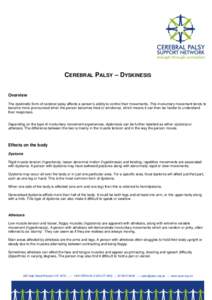 Date: 2013-10-08 06:03:50Medicine Hyperkinesia Athetosis Dystonia Hypertonia Cerebral palsy Focal dystonia Tardive dyskinesia Tic Neurological disorders Health Neurology | |  CEREBRAL PALSY – DYSKINESIS Overview The dyskinetic form of cerebral palsy affects a person’s ability to control their movements. This involuntary movement tends to become more pronounced when the person becomes tire CEREBRAL PALSY – DYSKINESIS Overview The dyskinetic form of cerebral palsy affects a person’s ability to control their movements. This involuntary movement tends to become more pronounced when the person becomes tire
Add to Reading ListSource URL: www.cpsn.org.auDownload Document from Source Website File Size: 249,34 KBShare Document on Facebook
|

